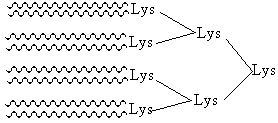Service
Product Search

Multiple Antigenic Peptides (MAP)
Multiple Antigenic Peptide is a one potent way to produce high-titer anti-peptide antibodies and synthetic peptide vaccines . This system utilizes the α- and Σ-amino groups of lysine to form a backbone to which multiple peptide chains can be attached. Depending on the number of lysine tiers, different numbers of peptide branches (2, 4, 8, or others) can be synthesized . The high molecular weight (compared with that of peptide) is suitable for immunizing without conjugation to a carrier protein.
Multiple Antigenic Peptide is a one potent way to produce high-titer anti-peptide antibodies and synthetic peptide vaccines . This system utilizes the α- and Σ-amino groups of lysine to form a backbone to which multiple peptide chains can be attached. Depending on the number of lysine tiers, different numbers of peptide branches (2, 4, 8, or others) can be synthesized . The high molecular weight (compared with that of peptide) is suitable for immunizing without conjugation to a carrier protein.
 MAP-4 |
 MAP-8 |
Characteristics
High molar ratio of peptide antigen to core molecule
Defined chemical structures
Choice of 4-branch, 8 branch, and others
Choice of mono-epitope or di-epitope
Advantages
Does not require the use of a carrier protein to elicit antibody response
Increased coating efficiency on solid surface
Enhanced detection sensitivity for solid phase immunoassay
Valuable for studies of immunology and vaccine studies
Guidelines
Average peptide length: 10-15 residues
Favored in N-terminal or internal peptide response
Not favored in C-terminal peptide response
Cysteines can cause low yield
Not amenable for further further purification
High molar ratio of peptide antigen to core molecule
Defined chemical structures
Choice of 4-branch, 8 branch, and others
Choice of mono-epitope or di-epitope
Advantages
Does not require the use of a carrier protein to elicit antibody response
Increased coating efficiency on solid surface
Enhanced detection sensitivity for solid phase immunoassay
Valuable for studies of immunology and vaccine studies
Guidelines
Average peptide length: 10-15 residues
Favored in N-terminal or internal peptide response
Not favored in C-terminal peptide response
Cysteines can cause low yield
Not amenable for further further purification









